Spring Festival 中国各地春节习俗(全英文)
- 格式:pptx
- 大小:1.31 MB
- 文档页数:10

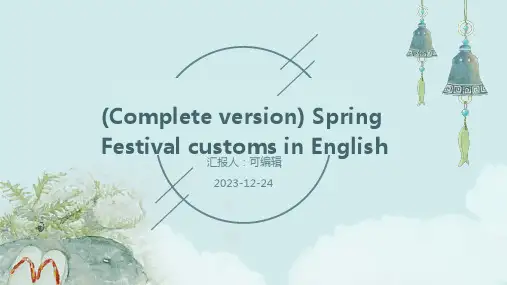

各地春节的风俗英文版作文英文:During the Spring Festival, different regions in China have their own unique customs and traditions. For example, in northern China, people often eat dumplings during the Spring Festival, as it is believed that eating dumplings can bring good luck and prosperity for the coming year. In addition, families in northern China also like to paste red couplets on their doors, which are meant to bring good fortune and ward off evil spirits.In southern China, people have the tradition of giving red envelopes to children and unmarried adults as a symbol of good luck and blessings. This is called "hongbao" in Chinese, and it is a way of sharing good fortune and spreading joy during the Spring Festival. In addition, people in southern China also like to set off firecrackers to celebrate the new year, as it is believed that the loud sound of firecrackers can scare away evil spirits and bringgood luck.中文:在春节期间,中国各地都有着不同的风俗和传统。
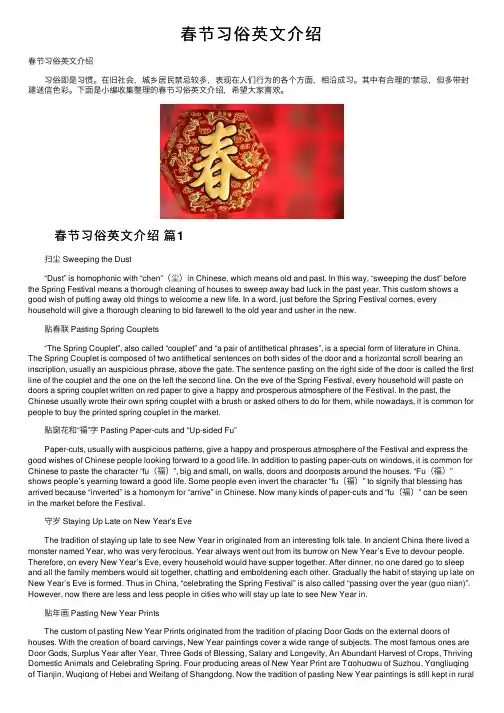
春节习俗英⽂介绍春节习俗英⽂介绍 习俗即是习惯。
在旧社会,城乡居民禁忌较多,表现在⼈们⾏为的各个⽅⾯,相沿成习。
其中有合理的'禁忌,但多带封建迷信⾊彩。
下⾯是⼩编收集整理的春节习俗英⽂介绍,希望⼤家喜欢。
春节习俗英⽂介绍篇1 扫尘 Sweeping the Dust “Dust” is homophonic with “chen”(尘)in Chinese, which means old and past. In this way, “sweeping the dust” before the Spring Festival means a thorough cleaning of houses to sweep away bad luck in the past year. This custom shows a good wish of putting away old things to welcome a new life. In a word, just before the Spring Festival comes, every household will give a thorough cleaning to bid farewell to the old year and usher in the new. 贴春联 Pasting Spring Couplets “The Spring Couplet”, also called “couplet” and “a pair of antithetical phrases”, is a special form of literature in China. The Spring Couplet is composed of two antithetical sentences on both sides of the door and a horizontal scroll bearing an inscription, usually an auspicious phrase, above the gate. The sentence pasting on the right side of the door is called the first line of the couplet and the one on the left the second line. On the eve of the Spring Festival, every household will paste on doors a spring couplet written on red paper to give a happy and prosperous atmosphere of the Festival. In the past, the Chinese usually wrote their own spring couplet with a brush or asked others to do for them, while nowadays, it is common for people to buy the printed spring couplet in the market. 贴窗花和“福”字 Pasting Paper-cuts and “Up-sided Fu” Paper-cuts, usually with auspicious patterns, give a happy and prosperous atmosphere of the Festival and express the good wishes of Chinese people looking forward to a good life. In addition to pasting paper-cuts on windows, it is common for Chinese to paste the character “fu(福)”, big and small, on walls, doors and doorposts around the houses. “Fu(福)”shows people’s yearning toward a good life. Some people even invert the character “fu(福)” to signify that blessing has arrived because “inverted” is a homonym for “arrive” in Chinese. Now many kinds of paper-cuts and “fu(福)” can be seen in the market before the Festival. 守岁 Staying Up Late on New Year's Eve The tradition of staying up late to see New Year in originated from an interesting folk tale. In ancient China there lived a monster named Year, who was very ferocious. Year always went out from its burrow on New Year’s Eve to devour people. Therefore, on every New Year’s Eve, every household would have supper together. After dinner, no one dared go to sleep and all the family members would sit together, chatting and emboldening each other. Gradually the habit of staying up late on New Year’s Eve is formed. Thus in China, “celebrating the Spring Festival” is also called “passing over the year (guo nian)”. However, now there are less and less people in cities who will stay up late to see New Year in. 贴年画 Pasting New Year Prints The custom of pasting New Year Prints originated from the tradition of placing Door Gods on the external doors of houses. With the creation of board carvings, New Year paintings cover a wide range of subjects. The most famous ones are Door Gods, Surplus Year after Year, Three Gods of Blessing, Salary and Longevity, An Abundant Harvest of Crops, Thriving Domestic Animals and Celebrating Spring. Four producing areas of New Year Print are Tɑohuɑwu of Suzhou, Yɑngliuqing of Tianjin, Wuqiɑng of Hebei and Weifang of Shangdong. Now the tradition of pasting New Year paintings is still kept in ruralChina, while it is seldom followed in cities. 吃饺⼦ Having Jiaozi On New Year’s Eve, the whole family will sit together to make jiaozi and celebrate the Spring Festival. The shape of jiaozi is like gold ingot from ancient China. So people eat them and wish for money and treasure. The tradition of having jiaozi is very important during the Spring Festival. You cannot have a complete Spring Festival without having jiaozi. (See page 82 for more information about “jiaozi”) 看春节联欢晚会 The CCTV New Year's Gala The New Year’s Gala is a variety show held by China Central Television (CCTV) since 1983. For every year since then at the turn of the Lunar New Year, the program begins at 8:00PM and lasts five or six hours. It brings laughter to billions of people, creates many popular words and produces lots of TV phenomena meriting attention. For over twenty years, its value has gone far beyond a variety show. It is essential entertainment for the Chinese both at home and abroad. Many Chinese would like to watch the gala while having the dinner on New Year’s Eve. 放鞭炮 Setting off Firecrackers The firecracker is a unique product in China. In ancient China, the sound of burning bamboo tubes was used to scare away wild animals and evil spirits. With the invention of the gunpowder, “firecracker” is also called “鞭炮biānpào” (“炮” in Chinese means gun) and used to foster a joyful atmosphere. The first thing every Chinese household does is to set off firecrackers and fireworks, which are meant to bid farewell to the old year and usher in the new. In the past few years, such an activity was completely or partially forbidden in big cities including Beijing due to fire and personal casualty caused by burning firecrackers. However, some Chinese thought that a Spring Festival without firecrackers was not lively enough and they burned firecrackers by stealth. So in recent years, the ban was canceled again. This shows that burning firecrackers is a very important activity during the Spring Festival. 拜年和压岁钱 New Year's Visit and Gift Money On the first day of the Chinese lunar year, everybody puts on their best clothes and pays ceremonial calls on their relatives and friends, wishing them all the luck in the coming year. Juniors will greet seniors, wishing them health and longevity, while seniors will give juniors some gift money as a wish for their safety in the coming year. When friends meet, they will wish each other happiness and prosperity with a big smile. With the development of the new technology, there is a change on the way of giving New Years greetings. In recent year, it is common to send New Years greetings by such modern means of communication as telephones, emails and text messages. 逛庙会 Temple Fair Temple fair, usually held outside temples, is a kind of folk custom in China. During the Spring Festival, temple fair is one of the most important activities, in which there are such performances as acrobatics and Wushu, numerous kinds of local snacks and many kinds of things for everyday life. In recent years, the temple fair has become a place for people to appreciate the traditional art and experience the traditional life. 春节习俗英⽂介绍篇2 春节正⽉习俗的英⽂介绍 The Chinese New Year celebrations are marked by visits to kin, relatives and friends, a practice known as "new-year visits" (Chinese: 拜年; pinyin: bài nián). New clothes are usually worn to signify a new year. The colour red is liberally used in all decorations. Red packets are given to juniors and children by the married and elders. See Symbolism below for more explanation. Preceding days 春节前 This article does not cite any references or sources. Please help improve this article by adding citations to reliable sources. Unsourced material may be challenged and removed. (January 2010) On the days before the New Year celebration Chinese families give their home a thorough cleaning. There is a Cantonese saying "Wash away the dirt on ninyabaat" (年廿⼋,洗邋遢), but the practice is not usually restricted onnin'ya'baat (年廿⼋, the 28th day of month 12). It is believed the cleaning sweeps away the bad luck of the preceding year and makes their homes ready for good luck. Brooms and dust pans are put away on the first day so that luck cannot be swept away. Some people give their homes, doors and window-frames a new coat of red paint. Homes are often decorated withpaper cutouts of Chinese auspicious phrases and couplets. Purchasing new clothing, shoes, and receiving a hair-cut also symbolize a fresh start. In many households where Buddhism or Taoism is prevalent, home altars and statues are cleaned thoroughly, and altars that were adorned with decorations from the previous year are also taken down and burned a week before the new year starts, and replaced with new decorations. Taoists (and Buddhists to a lesser extent) will also "send gods" (送神), an example would be burning a paper effigy of Zao Jun the Kitchen God, the recorder of family functions. This is done so that the Kitchen God can report to the Jade Emperor of the family household's transgressions and good deeds. Families often offer sweet foods (such as candy) in order to "bribe" the deities into reporting good things about the family. The biggest event of any Chinese New Year's Eve is the dinner every family will have. A dish consisting of fish will appear on the tables of Chinese families. It is for display for the New Year's Eve dinner. This meal is comparable to Christmas dinner in the West. In northern China, it is customary to make dumplings (jiaozi 饺⼦) after dinner and have it around midnight. Dumplings symbolize wealth because their shape is like a Chinese tael. By contrast, in the South, it is customary to make a new year cake (Niangao, 年糕) after dinner and send pieces of it as gifts to relatives and friends in the coming days of the new year. Niangao literally means increasingly prosperous year in year out. After the dinner, some families go to local temples, hours before the new year begins to pray for a prosperous new year by lighting the first incense of the year; however in modern practice, many households hold parties and even hold a countdown to the new lunar year. Beginning in the 1980s, the CCTV New Year's Gala was broadcast four hours before the start of the New Year. First day 初⼀ The first day is for the welcoming of the deities of the heavens and earth, officially beginning at midnight. Many people, especially Buddhists, abstain from meat consumption on the first day because it is believed that this will ensure longevity for them. Some consider lighting fires and using knives to be bad luck on New Year's Day, so all food to be consumed is cooked the day before. For Buddhists, the first day is also the birthday of Maitreya Bodhisattva (better known as the more familiar Budai Luohan), the Buddha-to-be. People also abstain from killing animals. Most importantly, the first day of Chinese New Year is a time when families visit the oldest and most senior members of their extended family, usually their parents, grandparents or great-grandparents. Some families may invite a lion dance troupe as a symbolic ritual to usher in the Lunar New Year as well as to evict bad spirits from the premises. Members of the family who are married also give red packets containing cash to junior members of the family, mostly children and teenagers. While fireworks and firecrackers are traditionally very popular, some regions have banned them due to concerns over fire hazards, which have resulted in increased number of fires around New Years and challenged municipal fire departments' work capacity. For this reason, various city governments (e.g., Hong Kong, and Beijing, for a number of years) issued bans over fireworks and firecrackers in certain premises of the city. As a substitute, large-scale fireworks have been launched by governments in cities like Hong Kong to offer citizens the experience. Second day 初⼆ The second day of the Chinese New Year is for married daughters to visit their birth parents. Traditionally, daughters who have been married may not have the opportunity to visit their birth families frequently. On the second day, the Chinese pray to their ancestors as well as to all the gods. They are extra kind to dogs and feed them well as it is believed that the second day is the birthday of all dogs. Business people of the Cantonese dialect group will hold a 'Hoi/jr/Nin' prayer to start their business on the 2nd day of Chinese New Year. The prayer is done to pray that they will be blessed with good luck and prosperity in their business for the year. Third and fourth days 初三 The third and fourth day of the Chinese New Year are generally accepted as inappropriate days to visit relatives and friends due to the following schools of thought. People may subscribe to one or both thoughts. 1) It is known as "chì kǒu" (⾚⼝), meaning that it is easy to get into arguments. It is suggested that the cause could be the fried food and visiting during the first two days of the New Year celebration.[citation needed] 2) Families who had an immediate kin deceased in the past 3 years will not go house-visiting as a form of respect to the dead, but people may visit them on this day. Some people then conclude that it is inauspicious to do any house visiting at all. The third day of the New Year is allocated to grave-vi s i t i n g i n s t e a d . / p >。
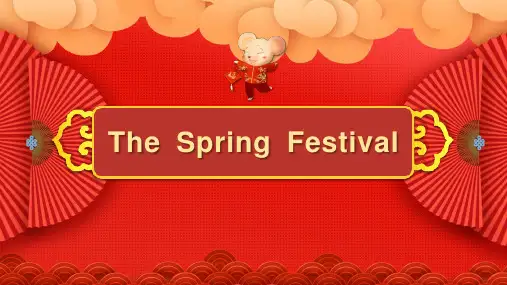
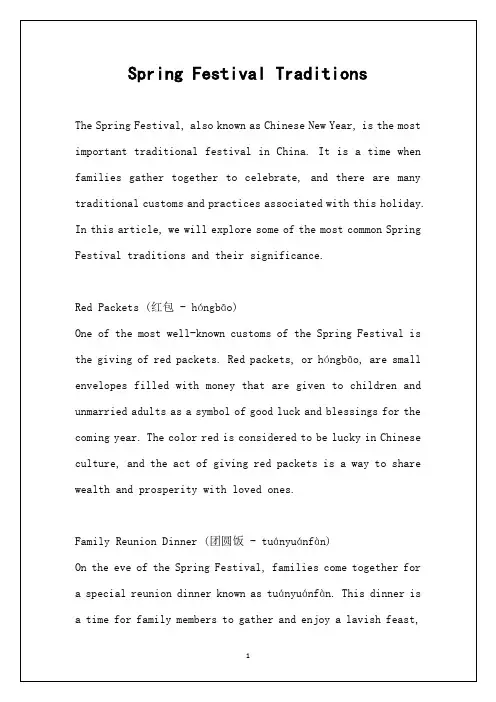


年初一到年十五传统春节风俗(中英文对照)说起圣诞节,估计大家都会滔滔不绝,但说起中国传统的春节,大家又知不知道怎么用英语来个简短介绍呢?赶紧来看看吧。
跟老外侃圣诞不算什么,不如侃侃春节。
不过很多这些风俗连小编自己都不了解,也许我们现在过的春节已经不是正宗的春节了吧。
New Year celebrations is a grand event of China. New Year festivitie lasts for one month in China. Chinese New Year is also called Spring festival. It begins from the middle of the last month of the year and ends up in the first month of the new year. These last day celebrations in China is called Lantern Festival.History of Chinese New Year 追溯历史:名叫“年”的怪兽ChineseNew Year has a very interesting and unique history. Accordingto the Chinese legends, there was a giant beast Nian who used to swallow humans in a single bite. Relief from the horrifying beast came only when people realized that Nian was scared of red color and loud noises.They started bursting crackers and used red color toscare the beast. Since then, this day was named as GuNian meaning "Pass over the Nian". Chinese considered the day an auspicious one as it brought new life for them and celebrated it as a New Year。
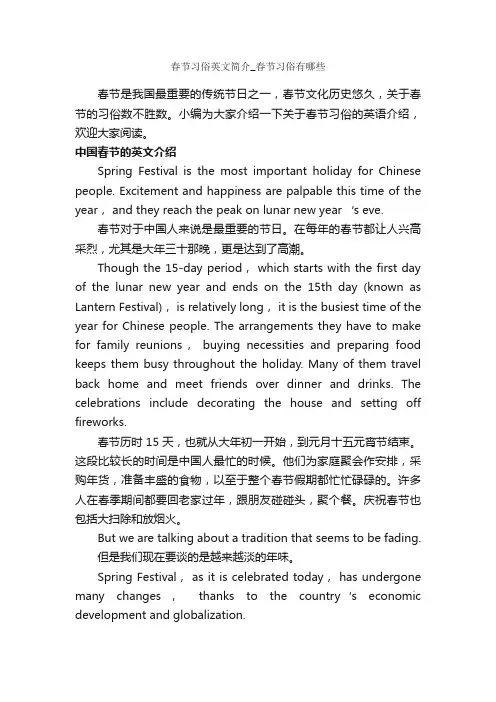
春节习俗英文简介_春节习俗有哪些春节是我国最重要的传统节日之一,春节文化历史悠久,关于春节的习俗数不胜数。
小编为大家介绍一下关于春节习俗的英语介绍,欢迎大家阅读。
中国春节的英文介绍Spring Festival is the most important holiday for Chinese people. Excitement and happiness are palpable this time of the year,and they reach the peak on lunar new year‘s eve.春节对于中国人来说是最重要的节日。
在每年的春节都让人兴高采烈,尤其是大年三十那晚,更是达到了高潮。
Though the 15-day period, which starts with the first day of the lunar new year and ends on the 15th day (known as Lantern Festival), is relatively long, it is the busiest time of the year for Chinese people. The arrangements they have to make for family reunions,buying necessities and preparing food keeps them busy throughout the holiday. Many of them travel back home and meet friends over dinner and drinks. The celebrations include decorating the house and setting off fireworks.春节历时15天,也就从大年初一开始,到元月十五元宵节结束。
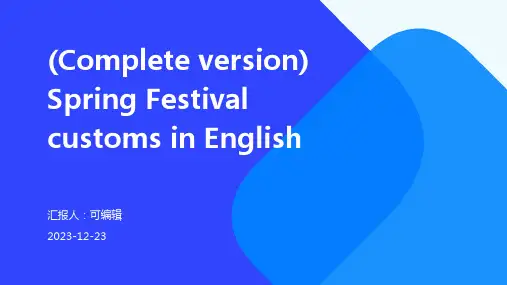
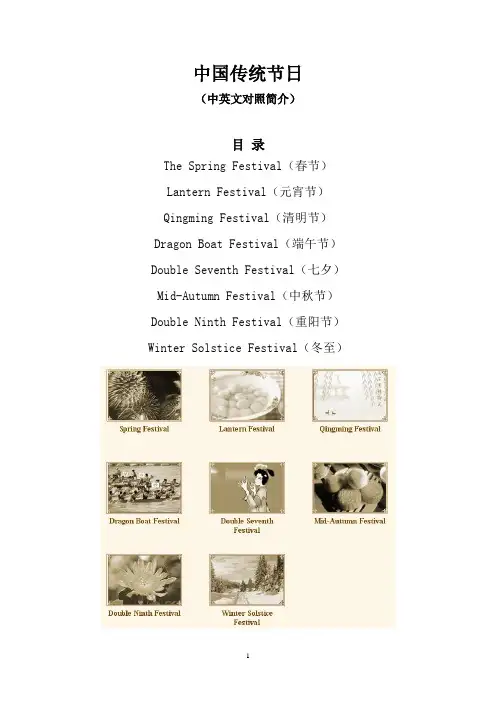
中国传统节日(中英文对照简介)目录The Spring Festival(春节)Lantern Festival(元宵节)Qingming Festival(清明节)Dragon Boat Festival(端午节)Double Seventh Festival(七夕)Mid-Autumn Festival(中秋节)Double Ninth Festival(重阳节)Winter Solstice Festival(冬至)The Spring Festival(春节)The first day of the first lunar month is the New Year in the Chinese lunar calendar. Among the traditional Chinese festivals, this is the most important and the most bustling. Since it occurs at the end of winter and the beginning of spring, people also call it the Spring Festival.Chinese have many traditional customs relating to the Spring Festival. Since the 23rd day of the 12th lunar montha, people start to prepare for the event. Every family will undertake thorough cleaning, do their Spring Festival shopping, create paper-cuts for window decoration, put up New Year picturesb, write Spring Festival coupletsc, make New Year cakesd, and also prepare all kinds of food to bid farewell to the old and usher in the new.New Year's Eve is the time for a happy reunion of all family members, when they sit around the table to have a sumptuous New Year's Eve dinner, talking and laughing, until daybreak, which is called "staying up to see the year out". When the bell tolls midnight on New Year's Eve, people eat dumplings. In ancient times, midnight was called zishi (a period of the day from 11 p.m. to 1 a.m.). Dumplings (jiaozi) are eaten because it sounds the same as "change of the year and the day" in Chinese.From the first day of the lunar year, people pay New Year calls on relatives and friends, which is an important custom for the Spring Festival.Setting off firecrackers is the favorite activity of children in the Spring Festival. According to legend, this could drive off evil spirits. The continuous sound of firecrackers can be heard everywhere, adding to the atmosphere of rejoicing and festivity.Many places hold temple fairs. The wonderful dragon lantern dance and the lion dance performances, along with various handicraft articles and local snacks attract thousands of people.With the development of the times, some changes have taken place in the customs of spending the Spring Festival. For example, to prevent environmental pollution, many cities have banned firecrackers. But this does not have an impact on the happy atmosphere of the festival. On New Year's Eve, family members get together to have dinner while watching TV programs.For Chinese at home and abroad, the Spring Festival is always the most important festival.农历的正(zheng)月初一,是中国的农历新年。
春节是中国及⼀些亚洲民族⼀个古⽼的传统节⽇。
因为相传年兽怕红⾊,怕⽕光和怕响声,所以⼈们便有贴春联、放鞭炮、敲锣打⿎等习俗。
不同时期、不同地区、不同民族的习俗都不相同。
Spring Festival is a traditional festival in China and some Asian nations. Because legend has it that the beast is afraid of red, afraid of fire and afraid of sound, so people will have couplets, firecrackers, gongs and drums and other customs. Different periods, different regions, different ethnic customs are not the same. 在中国,春节也是少数民族⼈民的风俗节⽇。
各族⼈民按照⾃已的习俗,举⾏各种各样的庆祝活动,具有各⾃浓厚的民族独特风采。
春节是中国⼀个古⽼的节⽇,也是全年最重要的⼀个节⽇,如何过庆贺这个节⽇,在千百年的历史发展中,形成了⼀些较为固定的风俗习惯,有许多还相传⾄今。
In China, the Spring Festival is also a minority national people's customs and festivals. People of all ethnic groups in accordance with their own customs, held a variety of celebration, with their strong national unique style. Spring Festival is an ancient festival in China. It is also one of the most important festival in the whole year. How to celebrate this festival, in the history of thousands of years, has formed some relatively fixed customs, there are still many people who have been handed down. 少数民族 Ethnic minority 在中国,春节也是少数民族⼈民的风俗节⽇。
中国春节10个风俗英文The Spring Festival, also known as Chinese New Year, is the most important traditional holiday in China, celebrated with a variety of customs and traditions. Here are ten customs associated with the Chinese Spring Festival:1. $$Spring Festival Eve Dinner (Nian Ye Fan)$$The eve of the Spring Festival, known as Nian Ye, is marked by a reunion dinner shared by family members. This meal is considered a symbol of unity and harmony, with dishes often symbolizing prosperity, good luck, and longevity. Some common dishes include fish (representing surplus and abundance), dumplings (symbolizing wealth and good fortune), and spring rolls (a roll-up of good luck).2. **Setting Off Firecrackers (Fang Pao Zhu)**Firecrackers are a crucial element of the Spring Festival, believed to scare away evil spirits and bring good luck for the new year. The loud bangs and bright flashes are also considered a way to celebrate and welcome the arrival of the new year.3. **Posting Spring Couplets (Tie Chun Lian)**Spring couplets, pairs of verses written on red paper, are posted on doors as a symbol of good luck and happiness. These couplets usually contain wishes for prosperity, health, and happiness in the coming year.4. **Giving Red Envelopes (Fa Hongbao)**Red envelopes, known as hongbao, are given to children, unmarried young adults, and elders as a gesture of good luck and blessing. The envelopes are usually filled with money, symbolizing prosperity and wealth.5. **Lion Dance and Dragon Dance Performances**Lion and dragon dances are traditional performancesthat bring joy and excitement to the festival atmosphere. These dances symbolize good luck, strength, and prosperity, often performed in public spaces or at private gatherings.6. **Cleaning and Decorating Homes**Before the Spring Festival, families thoroughly clean their homes to sweep away bad luck and make way for good fortune. Homes are then decorated with flowers, lanterns, and other festive ornaments to create a cheerful andfestive atmosphere.7. **Worshiping Ancestors (Zun Zong)**Many families in China have the custom of worshiping their ancestors during the Spring Festival. This involves offering incense, food, and drinks as a way to honor and remember deceased relatives, seeking their blessings for the new year.8. **Watching the Spring Festival Gala**The Spring Festival Gala, a television broadcast featuring a variety of performances such as singing, dancing, comedy, and acrobatics, is a popular tradition for many Chinese families. This event, often broadcast live on New Year's Eve, brings joy and entertainment to the festive occasion.9. **Feasting and Visiting Relatives (Chu Men拜年)**During the Spring Festival, families often feast together and visit relatives and friends, exchanging greetings and wishes for the new year. This tradition reinforces family ties and community bonds, promoting a sense of unity and warmth.10. **Observing the Fifteen-Day Festival**The Spring Festival actually lasts for 15 days, ending with the Lantern Festival on the 15th day of the first lunar month. This period is marked by various activities, including lantern displays, riddle-solving, and dragon dance performances. The Lantern Festival signals the end of the Spring Festival celebrations, bringing a festive and joyful conclusion to the holiday season.These are just some of the numerous customs and traditions associated with the Chinese Spring Festival. This festival, rich in history and culture, is a time for celebration, reunion, and the renewal of hope and dreamsfor the coming year.。
各地春节的风俗英文版作文英文:In different places, the customs of the Spring Festival vary greatly. Here, I will introduce some of them.In northern China, people usually eat dumplings on the eve of the Spring Festival. They believe that eating dumplings can bring good luck and fortune. During the festival, people also set off fireworks and firecrackers to drive away evil spirits and welcome the new year.In southern China, people have the tradition of eating niangao, a kind of sticky rice cake. It symbolizes the hope for a higher position, improvement, and growth in the coming year. People also clean their houses thoroughly before the Spring Festival to sweep away bad luck and make room for good fortune.In some regions of China, there is the custom of dragonand lion dances. The dragon and lion are believed to bring good luck and prosperity, so people perform these dances to pray for a smooth and successful year ahead.In Taiwan, people have the tradition of giving red envelopes containing money to children and unmarried adults. It is believed that the red color can ward off evil spirits and bring good luck. This custom is also practiced in many other Chinese-speaking regions.In addition to China, the Spring Festival is also celebrated in many other Asian countries, each with its own unique customs and traditions.中文:在中国的不同地方,春节的风俗各有不同。
春节习俗Spring Festival Customs春节是中国最盛大、最重要的节日。
春节期间,人们通常会做一些活动来告别过去令人沮丧的旧事,迎接来年积极的新事。
随着时间的推移,这些活动成为春节的特殊习俗。
你们知道在中国有哪些特别的春节习俗?让我们一起来看看吧。
Spring Festival is the most grand and important festival in China. During the Spring Festival, people usually do some activities to bid farewell to the old frustrating things of the past, and to welcome the new positive things of the next year. These activities become special customs of Spring Festival over time. What special Spring Festival customs do you know in China? Let’s find out what customs there are in the Spring Festival.一、打扫房子House Cleaning打扫房子是年底的清洁仪式。
每年农历新年到来之前,家家户户都会做一次大扫除,清理灰尘。
除尘意味着除去家里的贫穷和霉运,迎来新的好运。
House cleaning is a cleaning ritual at the end of the year. Every year before the coming of Chinese New Year, every household will do a house cleaning to clean up dust. Sweeping the dust means to remove the poor and bad luck at home, and usher new good luck.二、祭拜祖先Ancestor Worshiping中国是一个非常尊重祖先的国家。